|
Earn Money : $20.00 for registration and between $0.50 and $8.00 for every completed assignment !!! |
|
|
|
Europana:
Help us to maintain our site FREE, visiting, without commitment, to
our advertisers. Thanks for your support.
|
COLOGNE.
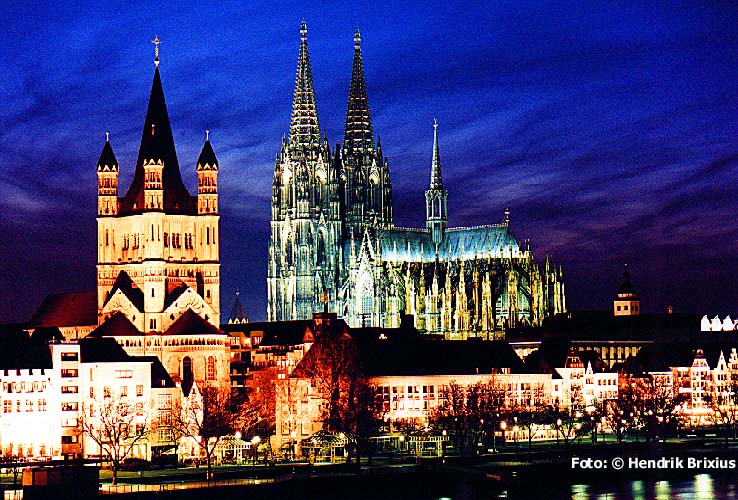 |
|
Night in Cologne. (Foto by Hendrix Brixius)
|
Cologne, is the oldest between the great German cities and offers much historical information. Founded for 2,000 years, by the Romans, the city has been an alive source of this time. For the visitors, Colony offers a diversity of attractive which go from the cultural and historical treasures, passing by the museums and the musicals, until arriving at the famous carnival. The city has more of a million inhabitants but, in spite of this size, is very hospitable and with friendly people.
 |
|
Rin river in Cologne. (Foto by Hendrix Brixius)
|
Some Historical Data:
Cologne, is the older main city of Germany. Its name was assigned by the Roman Empress Agripina; wife of the emperor Claudius. Agripina was born in the neighborhoods of the Rin river and elevated her "Cologne" to estatus of a city in the year 50 A.D.
Today, is possible to find, signs of the Roman time, when journeying by the city, like for example, the mosaic of Dionisios in the Römisch-Germanisches Museum (Roman-Germanic Museum); the sections of the Roman wall of the city, and the Roman system of the water, that carried the fresh water to the Roman city from the Eifel region.
The Roman network of streets, still is reflected in the present disposition of the streets in the city. The Hohe Strasse, for example, a street occupied today, by the purchases between the cathedral (Dom) and the Neumarkt, has a history of two thousand years within the economic and social life of Cologne.
The Christianity also was inherited by Cologne of the Romans, and due to its importance, the city in a moment became seat of a bishopric. On year 785, Charlemagne founded the Archbishopric of Cologne, granting, at the same time, secular powers to the leaders of the church. The Archbishop of Cologne became thus, in one of the gentlemen with more power in the roman saint empire.
From century XXII, Cologne has been the fourth metropolis, in addition to Jerusalem, Istambul and Rome, in taking the designation " Sancta" (saint) in the name of the city: " Cologne saint, faithful daughter of the Roman church by the tolerance of God"
In 1164, Rainald von Dassel, imperial chancellor and Archbishop of Colony, took to Colony " the Shrine of the Three Kings ". To his death, was considered in erecting a powerful cathedral, the "greater north of the structure of mountains" in his honor. The stone of the foundation was put the 15 of August 1248. Nevertheless, the construction was not finished until 1880.
The first municipal university in Europe was founded on Colony in 1388.
TOURIST ATTRACTIVE:
Cathedral of Cologne (Dom):
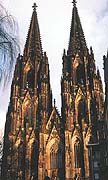 |
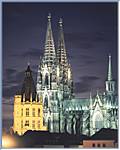 |
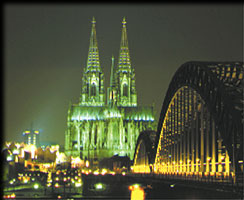 |
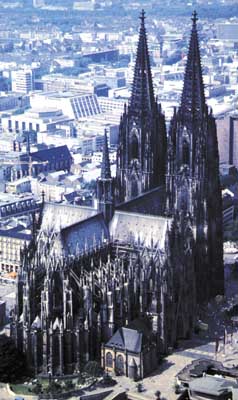 |
|
Cathedral of Cologne. (Dom) |
|
The cathedral of Cologne or Dom with its two towers of 157 meters of height, is the symbol of the city for the centuries, and the architectonic monument more known of Germany. It took 632 years until the construction of the cathedral was finished. After its beginning in year 1248, the work of construction was gradually stopping until stop, in 1560. With the romantic enthusiasm of the XIX century , and the consolidation of the prusians, the work of construction was started again in 1842. In 1880, after 632 years, the cathedral finally was finished, and this event was celebrated in all the country.
Exceptional works of art are lodged in the enclosure and the compartment of the treasure of the cathedral; among them are : The Shrine of the " Three Holy Kings "of particular importance for the Christian world; and "the Sarcophagus of Epiphany" (century XXIII) that exceeds to anyone sarcophagus of gold in the western Christian, in terms of the beatuy and scale. It is interesant also the frame of the bell "dicker Pitter" (1923), one of the greats oscillating bells of the world, located in one of the towers of the Cathedral.
 |
|
Shrine of the Three Kings. Located in the enclosure of the Cathedral. |
Museums:
The elements characteristic in the Cologne history: the commerce, the transformation and the transport, the religion and the veneration of the saints, and the modern art are combined within an area highly confined in the center of city, that incorporates to the central railroad of Cologne (1890 - 1894) and its restored steel and crystal structure, the cathedral and museums (museum of Ludwig, museum of Roman-Germanic).
The museum of Ludwig, is the most famous of the eight municipals and the many ecclesiastical and privated museums in this city; located near the cathedral, it provides a description of important international works of art.
The Roman-Germanic museum (Römisch-Germanisches) gives an impressive account of the history of the Romans along the Rin river.
With the museum of Rautenstrauch-Jost, the city also has the only etnologic museum in the state of Rhine-Westphalia of the north.
The very ample range of private museums extends from the impressive sacral art in the diocesano museum or the center of the art of the St. Peter; passing through the photographic collection of the cultural foundation of SK until arriving at the museum of POPDOM with the outbreak of the design of the Sixties and seventy; or to the German museum of the sport and the Olympic Games.
The museum of Imhoff-Stollwerck, or museum of the chocolate, located in the Rheinauhafen provides a sweet moment and contains all the worthy one to know and to prove around the history of the chocolate.
OTHER INTERESTING SITES:
Roman door of the North:
Located in the neighborhoods of the Cathedral.
Praetorium:
In the Praetorium the bases of the residence of the Roman governor of the city can be observed (Centuries I - IV); they were located under the Rathaus (City council). A visit to this enclosure, is as " a trip in elevator again to the Roman times ". Of the entrance to the Kleine Budengasse, there is also access to a channel of residual waters, exemplifying the abilities of engineering of the Roman constructors.
 |
|
|
Rathaus. |
|
 |
 |
|
Praetorium.
|
|
Roman Tower.
Tower of the corner the northwest of the Roman fortifications; well-preserved decoration of the mosaic. (Zeughausstrasse/St. Apernstrasse).
Krieler Dömchen.
In the smallest and older church of Cologne, erected around year 900 in the Suitbert-Heimbach-Platz; three commemorative stones of Carolingian, in the cemetery, say of a church that was stopped in the same site and was destroyed previously by the normands.
Roman Churches.
Cologne is a city of churches, like no other German city; twelve great Schools, Monasteries and Churches-Convents are located in the area within the limits of the wall of the old medieval city. Between the churches we can mention: Groß Broad St. of Mars, St. Maria Lyskirchen, St. Severin, St. Kunibert, St. Gereon, St. Pantaleon, St. Maria im Kapitol, St. Aposteln, St. Andreas, St. Ursula, St. Cäcilien and St. Georg. Frequently are offered concerts in these churches.
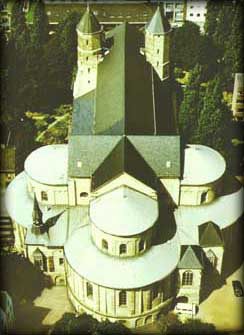 |
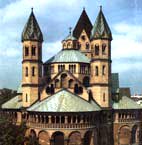 |
|
St. Maria im Kapitol
|
Iglesia de Los Santos Apóstoles
|
City Hall, Hansasaal
The hall or city enclosure, was constructed in 1330. This building suffered serious damages during World War II, and the reconstructions finalized in 1972. (It alters Markt).
Doors of the City.
The Severinstor, the Eigelsteintor and the Hahnentor, three of the total of the twelve doors that comprised of the wall or medieval wall of the city (1180 - 1220), have been preserved, and still they are used today towards several intentions.
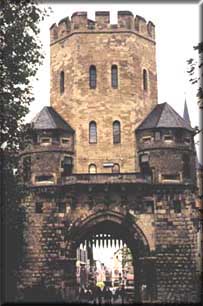 |
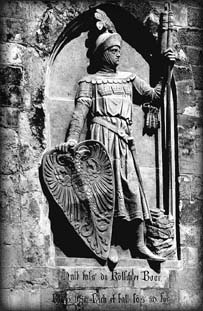 |
|
Severinstor
|
Eigelsteintor
|
Casas de la Ciudad / Fish Market:
Houses of the city (centuries XIV and XVII) located around the old market and in the district of Martinsviertel (historical center).
Zeughaus:
Before a municipal arsenal (1594-1606); now museum of the city.
Hansahochhaus:
Hansahochhaus, for the date of its construction, in 1920, was the " higher skyscraper" of Europe; today is a building with administrative offices for publicity and announcements. It contains the warehouse with the amplest selection of audio average in Europe (Hansaring)
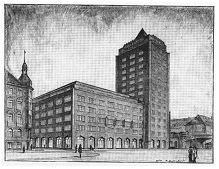 |
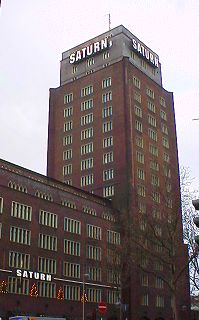 |
|
Hansahochhaus in 1925
|
Hansahochhaus today
|
Flora/Zoo:
The gardens were planted in 1863, according to designs of Peter Jose Lenné and Jose María Olbrich. The botanical garden was added in 1914. The site, that was destroyed during World War II, was restored totally and now it has a terrace of approximately 12000 species of plants. The zoological park of Cologne is located directly in the neighborhoods of the gardens.
4711 House:
It is " the new" gothic office for the manufacturer of the world-wide famous " eau de cologne ". the number " 4711" refers to the system of numeration of the houses adopted by the forces of French occupation in 1795; which, for the greater clarity, numbered all the privated houses of the city, in sequential way between numbers 1 and 7404. (Glockengasse).
House of Opera and Theater:
Both buildings, located in the Offenbachplatz, were constructed, between 1957 and 1962, by Wilhelm Riphahn and respectively have a capacity of 1400 and 920 assistants.
Exhibition halls/Rheinpark/Tanzbrunnen
The hall KölnMesse exhibition in the right border of the Rin, with its tower of more than 80 meters, located before the cathedral, is designed with the tendency of years 20. During years 40, it served like concentration camp.
Adjacent to the KölnMesse is the Rheinpark, a designed green area in the pure style of 50 years; with a park of sculptures, the source of Tanzbrunnen and the Sternwellenzelt, made by the architect Frei Otto, (who also designed the Olympic stage of Munich)
Museum Ludwig / Filarmonic Orchestra / Historical Center.
Historical center of Colony, was readjusted totally in the Eighties with the construction of the museum and the building of the filarmonic orchestra.
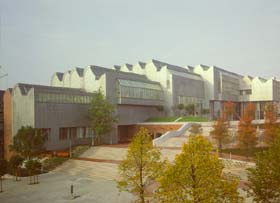 |
|
Museum Ludwig / Filarmonic Orchesta/ Historical Center. |
KölnArena
KölnArena, is the greatest and modern multi functional scene in Germany, being able to lodge up to 8,000 spectators; it is the seat of the club of ice hockey, the multiple german champions, Kölner Haie (Sharks of Cologne).
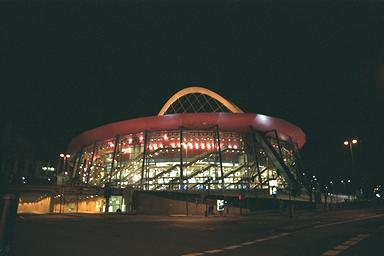 |
|
KölnArena
|
|
Sources for the processing of this site:
|
||
|
http://www.koeln.de/
(Official Web Sitel)
|
||
NOTE OF THE WEBMASTER: The information and the photographies including in this site, have been obtained in pages of Internet that offer their content gratuitously. These paginas did not give legal warning to their visitors on the author right (copyright) who on them could have. If the author of the photographies that appear in this page wishes that they are retirements, please to communicate with us through the electronic mail and they will be retired immediately
